|
In the previous
edition of Fish Tales I introduced the ever-popular genus
Pseudanthias. I will intentionally avoid a recap because
that
column can still be read in its entirety, but I ended
it with a cliffhanger leading right into the Meet the Species
section. You've paid your dues and waited long enough; there
is no need to make you wait any longer. Grab your drool towel
as neither myself nor Reefkeeping Magazine can be held
responsible for short-circuited keyboards, due to the outstanding
beauty and magnificence of these fish.
|
The beauty of this Pseudanthias tuka cannot be
denied.
Photo courtesy of Dr. Robert A. Patzner.
|
Meet the Family
In varying degrees,
all Pseudanthias species can be considered attractive
fish. Although some species are certainly more striking than
others, it's safe to say that not a single species would be
netted from your aquarium for having dull coloration. Unfortunately,
not all species are meant to be housed in home aquariums in
the first place. With a genus as diverse as Pseudanthias,
I'm often disappointed by the number of people who continue
to generalize these species. Among the most common generalizations
heard is the ever-infamous, "All Anthias need
to be kept in schools," or the almost as oft-proclaimed,
"All Anthias are hardy aquarium fish." Well,
this is not true, but as noted in my previous article,
the marine aquarium hobby still refers to Pseudanthias
as Anthias. Without a doubt, the vague generalizations
are immediately wrong because this statement refers to a genus
with a different name. Additionally, very few generalizations
should be made about the genus Pseudanthias as a whole.
The subgenera within Pseudanthias can almost
be generalized however, and this offers me an ideal way to
break down the large genus and discussing its subgenera individually.
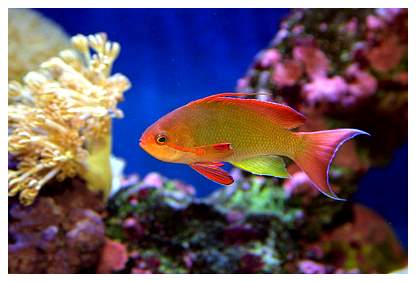 |
|
Another beautiful Anthiinae, this Pseudanthias squamipinnis
is seen here in a home aquarium. Photo courtesy of Mark
Ridley.
|
The Subgenus Franzia
The family's bullies can be found
in the subgenus Franzia. The three Franzia species
are all aggressive toward conspecifics, as well as other tankmates.
Because only three species comprise this subgenus, generalizations
about Franzia are a bit more accurate merely because
the limited number of species restricts their variation, but
not always. Neither of the other two subgenera can be generalized
as successfully. Despite their desire to kick the snot out
of their tankmates, the three Franzia species are also
easily kept and considerably hardy. Matched with other aquarium
fish that can hold their own, they make ideal residents for
the home aquarium.
I have mentioned how Franzia can almost be accurately
generalized. I say almost because Pseudanthias fasciatus
(photos below) is one of the three species in the subgenus
that differs from the others. This particular species is not
threatening to conspecifics or even other tankmates. In fact,
a peaceful aquarium is a requirement for keeping these fish
successfully. Smaller, peaceful fish such as Leopard wrasses,
cardinalfish and gobies should be considered ideal. A deeper
water species, usually located at depths below 100' and approaching
500' at times, the Redstripe Anthias (no relation to the Jamaican
zymurgy export) does best in aquariums which are dimly lit.
Thus, hard coral aquariums with intense lighting do not facilitate
keeping these fish. In addition to providing a lower light
aquarium, overhangs tend to help peaceful fish settle in to
captive life more quickly. In the wild, this species is not
found several meters off the reef wall, but instead is found
upside down with its abdomen oriented up toward the roof of
a cave or overhang. This is in direct contrast to what many
hobbyists think of when they discuss Anthias. Most
hobbyists immediately picture Anthias as existing in
huge schools of fish feeding above the reef. The natural habitat
and behavior for P. fasciatus can be recreated in the
home aquarium given the correct rockwork aquascaping that
incorporates caves and overhangs in the décor. The
Redstripe Anthias is a large Pseudanthias, reaching
8" as an adult male. It is fairly common around Japan,
yet extends southward to the Great Barrier Reef. Deep water
specimens have recently been discovered from the Red Sea and
southern Africa.
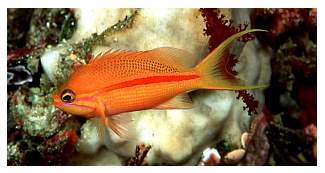 |
 |
|
Pseudanthias fasciatus. Photos courtesy of John
Randall.
|
Toward the opposite end of the aggressiveness spectrum is
the Redcheek Anthias (photos below). Pseudanthias huchtii
is a mean-spirited aquarium fish best kept as the lone Anthiinae.
Groups of 10 or more are possible, but require a very large
aquarium; thus my recommendation is to stick with a single
individual. In the wild, this species interacts with P.
squamipinnis, but unless you have a large enough aquarium
to display a small school of P. squamipinnis, it is
best not to mix this species with any other Anthiinae. This
particular species is rarely found deeper than 65' in the
wild, thereby making it a great selection for a brightly-lit
aquarium. Because it is common in the Philippines and Indonesia,
in addition to generally preferring shallow water, aquarists
have the opportunity to purchase them easily enough at a relatively
low cost.
|
Pseudanthias huchtii. Photos courtesy of John
Randall.
|
Perhaps the most commonly kept Pseudanthias is the
final member of the Franzia subgenus. While hobbyists
prefer to call them Lyretail Anthias (photos below), ichthyologists
have named them P. squamipinnis. Much of the information
that hobbyists broadly espouse about the entire Pseudanthias
genus originates with this particular species. Popular images
of Pseudanthias shoals consisting of over 2000 individuals
are typically photos of the Lyretail riding several meters
above the reef. This is because Lyretails prefer to ride the
currents on steep drop-offs above the reef crest while feeding
during daylight hours. Combining all of the above mentioned
tendencies of Lyretails, such as concentrating in excess of
several thousand and consistently appearing in open water,
countered with a natural depth range from 60' to 130', and
knowing that Lyretails can be found in the wild in a vast
area encompassing the Red Sea to New South Wales, Australia,
it should come as no surprise that Lyretails are a favorite
target for native fish collectors. Despite the large number
of shoaling fish in the wild, shoals in the aquarium rarely
work over the long-term unless the aquarium holds several
hundred gallons, and unless a shoal of eight or more individuals
is kept with only one male. This is because the male's aggression
can then be dispersed over all the animals in a large
group, generally resulting in a shoal that does not slowly
disappear. With fewer individuals in the shoal the aggression
can be concentrated, ultimately leading to the demise of the
weakest fish, and this continues to occur until the male is
all alone. This aggression will be directed not only toward
conspecifics or even other species of the genus, but most
likely all planktivores found in the aquarium will
be victimized. Small wrasses and the like will be harassed
and will need plenty of hiding places should you decide to
keep a male Lyretail with them. Dwarf angels display a personality
more conducive to the Lyretail aquarium. The Lyretail, much
like its close cousin, P. huchtii, does not quite reach
an adult length of 5".
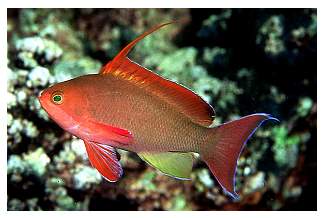 |
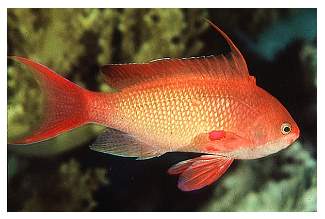 |
|
Pseudanthias squamipinnis. Photos courtesy of
John Randall.
|
The Subgenus Mirolabrichthys
The second subgenus
to discuss is Mirolabrichthys. The good: Most
fish in this subgenus are non-aggressive. The bad:
Most fish in this subgenus are prone to an early demise in
the home aquarium.
|
|
|
Bartlett's Anthias.
Photo courtesy of Robie Sayan.
|
To open this subgenus' discussion I'll
start with Pseudanthias bartlettorum, or what's commonly
called Bartlett's Anthias, simply because it is exactly opposite
of most fish in this subgenus. It is easy to care for, readily
adapts to aquarium life and is a pugnacious little bugger,
ready and willing to defend its home turf. If you ever get
a chance to witness this behavior, it may surprise you that
a fish as small as 3" has so much fight in it. Call it
Napoleon's complex, I suppose. Therefore, it's best to keep
only one male per aquarium unless you have an aquarium of
several hundred gallons or more. In that case, the standard
line for aggressive Pseudanthias holds true: keep a
single male with eight or more females. Although Bartlett's
Anthias do not form shoals nearing the same proportions as
P. squamipinnis in the wild, they do prefer much the
same type of habitat. Crystal clear water with a strong current
on exposed steep reef drop-offs tends to collect smaller shoals
consisting of a couple of males and up to 30 females. Depths
down to 100' hold concentrations of this species around a
few select islands, namely, the Marshall and Line Islands.
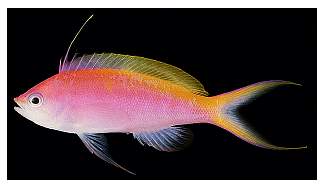 |
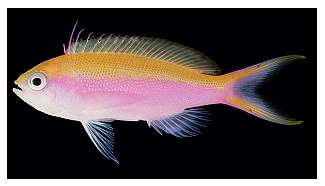 |
|
Pseudanthias bartlettorum - both males. Photos
courtesy of John Randall.
|
|
|
|
Bicolor Anthias.
Photo courtesy of John Randall.
|
Just about every colorful marine fish genus contains an individual
named "bicolor" based solely on its two-toned coloration.
Pseudanthias are no different, and the pink and orange
Pseudanthias first described by Randall (1979) has
been awarded this often used common Latin name. One good aspect
of the name is that both hobbyists and ichthyologists alike
can readily agree on Pseudanthias bicolor, the Bicolor
Anthias, as an appropriate name. In fact, even though it took
an ichthyologist to officially name this species, Randall
(1979) reports that the local "fish fanciers in Hawaii
already have begun to use the common name of 'Bicolored Bass'
for this species" prior to his recognized description.
Unlike many members of the subgenus Mirolabrichthys,
this is an Anthias which should warrant serious consideration
for your home aquarium. The majority of Bicolor Anthias are
deeper-water specimens, often found as deep as 200'. It is
doubtful that our aquarium arrivals were captured that deep,
however, because it is not uncommon for them to also be found
at 20' of depth. Nevertheless, Bicolor Anthias require a suitable
cave to retreat into, mimicking their natural environment.
Single individuals are best in the aquarium unless, of course,
(repeat the mantra after me) "a single male to eight
or more females" can be adequately kept in a large aquarium.
In the wild the Bicolor occasionally mixes with P. thompsoni,
and in the aquarium this could represent an interesting mix.
Pseudanthias dispar (photos below) is more typical
than the Bicolor Anthias of the subgenus Mirolabrichthys.
They are prone to harassment from more belligerent aquarium
mates, thereby requiring a peaceful aquarium, and they are
not considered hardy fish once imported into the aquarium
trade. Should you wish to try your hand with P. dispar,
beginning with several individuals is probably a better bet
than starting with a lone individual. Several males can even
inhabit the same aquarium, provided the ratio of females to
males favors the ladies and the aquarium is several hundred
gallons. As they are rarely found deeper than 50', and more
than likely are found in the 20' range, they do make good
candidates for a brightly lit aquarium. Pseudanthias bartlettorum
and P. squamipinnis are regularly found intermixing
with Dispar Anthias throughout the western Pacific.
|
Pseudanthias dispar- left photo - male, right
photo - female.
Photos courtesy of John Randall.
|
Another beautiful, but delicate and difficult, species is
Pseudanthias evansi - Evan's Anthias (photos below).
Success with this fish is unlikely over the long term, as
the Evan's seldom adapts well to captivity, and rarely, if
ever, acclimates to the home aquarium. Large shoals numbering
several hundred fish are a common sight on reefs throughout
the Indian Ocean extending eastward to the Mauritius Islands,
but their shoaling tendency hinders keeping them successfully
in the home aquarium. Should you wish to tempt fate by trying
to keep this species, a peaceful aquarium is a prerequisite
for success. Adults reach roughly 5" in total length,
about average for Pseudanthias species. If success
comes your way in maintaining this species, an interesting
display can be achieved by adding an Ecsenius midas,
a blenny which associates with the Evan's Anthias and occasionally
adjusts its coloration to resemble the Pseudanthias.
|
Pseudanthias evansi. Photos courtesy of John
Randall.
|
As should already be obvious, P. evansi are not the
only Pseudanthias which has a difficult time adapting
to the home aquarium. Acclimation of P. ignites, for
example, is nearly impossible without the aid of live food.
Now, considering how much food a single Anthias requires
(a lot), offering live foods as the staple of their diet can
become rather expensive, and may not even be an option depending
on where you are located and the quality of your local fish
store. Using live foods to assist with acclimation is ideal,
but it is also ideal to wean the fish off live foods and onto
traditional aquarium fare as quickly as possible. Struggling
to reach 3" in length as a full-grown adult, Flame Anthias,
as they are called by the marine ornamental industry, are
among the smallest Anthias species. Up to a dozen specimens
can be maintained in a peaceful aquarium upwards of 200 gallons
or more - including several males. One or two female P.
squamipinnis individuals can be added to the mix for an
interesting display, as these two species often relate to
and intermingle with each other in the wild. Sometimes this
species is also called the Indian Flame, no doubt referencing
its distribution throughout the Indian Ocean.
|
|
|
Lori's Anthias.
Photo courtesy of John Randall.
|
An easy to keep species of the subgenus Mirolabrichthys
is Pseudanthias lori. The Latin name begets the common
name Lori's Anthias, but on occasion this fish might be labeled
as the Tiger Queen Anthias. Unfortunately, this is a moderately
plain looking species for the genus, and I say unfortunately
because they are a rather hardy species for aquariums. Perhaps
their only downfall is the greater depths they inhabit, but
aquarium residents are surely not collected from the species'
maximum reported depth of 225'. No doubt any specimens showing
up at your local fish store are from less than 100', but even
these are rarely found above 70'. Of the shallow water specimens
(if 70' can be called shallow), they are most often found
underneath overhangs or within cavern systems. If these fish
are added to a brightly-lit aquarium, suitable overhangs should
be provided. Otherwise, all traditional Anthias precautions
still apply - keep one male per aquarium with several females
if aquarium space allows and feed heavily. This average-sized
Pseudanthias, less than 5" in length at adulthood,
most likely hails from the Philippines when it appears in
the aquarium trade, but the Tuamotu and Loyalty Islands also
hold a good stock of P. lori. To create the natural
relationship often found in the wild, P. smithvanizi
can be mixed into the aggregation of aquariums housing Lori's
Anthias.
 |
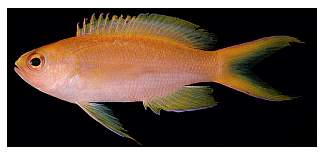 |
|
Pseudanthias parvirostris- left photo - male,
right photo - female.
Photos courtesy of John Randall.
|
|
Pseudanthias parvirostris - left photo - male,
center photo - female, right photo - male.
Photos courtesy of Hiroyuki Tanaka.
|
Easy to keep, yet difficult to obtain, the photos of P.
parvirostris (above) simply do not do this species any
justice. I do not care for the common name of Diadem Anthias
for this species, merely because it is a "common"
name for an uncommon aquarium fish. Photos are difficult to
come across because of this species' deepwater nature. It
is rare to encounter this fish above 100' deep, thereby making
it an expensive aquarium fish on the rare occasions it appears
in the trade. It is a hardy species, however, when not placed
in brightly-lit aquariums. If the lighting is too intense,
it will not adapt to captive conditions, whereas a dimly-lit
tank generally encourages a successful transition. Other non-aggressive
dither fish will assist in the transition as well. This small
Pseudanthias, reaching roughly 3 - 4" in length,
is regularly encountered at deeper depths in the Philippines
and southern Japan, but can also be found associating with
larger schools of P. smithvanizi throughout the western
Pacific. When attempting to recreate a small shoal, add females
of P. smithvanizi, as these species naturally coexist
in the wild. At least one author (Michael, 1998) has noted
the Indian Ocean residents' different coloration, possibly
warranting a separate species designation.
|
|
|
The Queen Anthias.
Photo courtesy of John Randall. |
The Queen Anthias - what an amazingly beautiful fish! It
is a large Anthias, reaching nearly 7" in length
as an adult. For those keeping track, ichthyologists and astute
hobbyists refer to this species by its Latin name, Pseudanthias
pascalus. This species' affordable price tag is mostly
due to its shallow collection depths and vast geographic distribution.
Indonesia, French Polynesia, Japan, the Great Barrier Reef,
New Caledonia and Sulawesi all hold concentrations of this
species. Although this fish can be found down to 200' of depth,
aquarium specimens are generally collected from 50' or less.
The biotope most commonly preferred by this species is highly
variable - from steep drop-offs to shallow rubble zones -
yet they all share one common element - strong water movement.
Slack water movement is not tolerated. While hovering high
up in the churning water column this species gathers in groups
to feed. Getting this fish to feed in captivity is a formidable
task, however. Most specimens starve to death from refusing
to eat, thereby making it a difficult species to keep and
less than ideal for most hobbyists. Again, the one male to
multiple females ratio is ideal, as well as providing several
feedings per day. Among the female collective, try tossing
in a few P. tuka, a closely-related species discussed
below. Another interesting addition would be Hoplolatilus
starcki, the Starck's tilefish, a natural mimic of P.
pascalus.
Having just discussed the Queen Anthias, now it is time for
the Princess. This fish has already been touched upon in many
of the preceding descriptions - this is the P. smithvanizi
(photos below) that relates to so many other Pseudanthias
species. The male Princess (hey, it's the 21st
century) is more vibrant than the females, but regardless
of gender, this species does not acclimate to the home aquarium
as well as the genus' other species. It remains reclusive
and has a difficult time adjusting to captive foods. In the
wild large schools do not congregate together, but rather
small shoals of 20 - 30 individuals, mostly females, hover
within several feet of the ocean bottom. The majority of individuals
prefer depths beyond 100' and upwards (or is that downwards?)
of 200', but those individuals appearing for sale in the trade
are obviously not collected from those depths. Although not
common, these fish can be located as shallow as 20', and these
are, no doubt, the specimens that are typically harvested
for the trade. Adults do not quite reach 4" in length.
The Great Barrier Reef and Marshall Islands would be ideal
locales should the desire to swim with P. smithvanizi
in the wild overtake you.
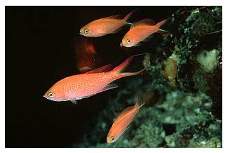 |
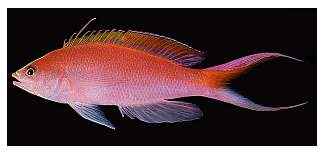 |
|
Pseudanthias smithvanizi - left photo - females,
right photo - male.
Photos courtesy of John Randall.
|
One of my favorite Pseudanthias is the Purple Anthias,
P. tuka (photos below). It is similar to P. pascalus,
and the two species are easily confused. Pseudanthias tuka
remains average-sized for Pseudanthias genus, not quite
reaching 5". The disappointment with this species is
the difficulty in providing suitable captive care. Similar
to all difficult-to-keep Pseudanthias species, adapting
to captive aquarium foods and adjusting to captive life in
general are the biggest hurdles. Introducing these fish into
a very passive aquarium is necessary should you expect to
achieve long-term success. Small, passive dither fish such
as Nemateleotris species, which are already successfully
eating captive foods, may assist with acclimation. Even then,
it is an uphill battle and one probably best not attempted
by the majority of hobbyists. Located from Japan to the Great
Barrier Reef and throughout Indonesia at depths less than
100' assures that this species is easily obtained within the
aquarium trade at a reasonable price - perhaps unfortunately,
given its poor captive care track record.
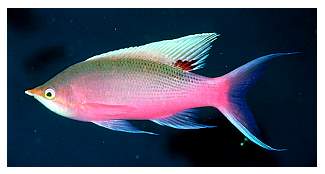 |
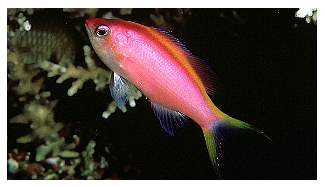 |
|
Pseudanthias tuka - left photo - male, right
photo - female.
Photos courtesy of John Randall.
|
Conclusion
A large number of
Anthiinae remain to be discussed and, therefore, the next
edition of Fish Tales will continue along this path as it
concludes the Pseudanthias genus discussion by concentrating
on the subgenus Pseudanthias and other popular Anthiinae
from genera outside Pseudanthias.
|

